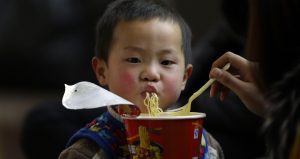Noodles, as many of Italians and Chinese’s soul food, definitely represent who we are. It reflects what history that you had, what region you are in, what city you are from, what kind of culture background you have.
Noodles always contain rich historical background. When you know about Chinese noodles, you will be noticed how they evolve through the time. As the authors from the “Noodle, traditionally and today” mentioned, Chinese noodles have a long history, from Han dynasty, and how they evolve throughout the time. At first, it was only as cake (饼), and then, shui yin (水引) and bo tuo(馎饦). The improved methods and techniques of making noodles improved, therefore, the Leng tao ( 冷淘) and other variable flavors appeared. When I was reading about Song (宋) and Yuan (元) dynasty period, these noodles name sounds familiar: fine dried noodles (挂面), vegetable raw noodles (素面), five spicy noodles (五香面) and eight treasures noodles (八珍面); I believe I had them in my life. For Italian Pasta perspective, the pasta history aligns with the history of Italy. Like the author of “Table Practices and Manners” mentioned in the chapter “Pasta and the Italians: a single and multiple identity”, “Italy has played a leading role in the history of establishing and disseminating the culture of pasta. Two traditions merged on Italian territory: the ancient Roman……and the Middle Eastern”. Pasta also evolves throughout the time. From the same chapter of this book, the new techniques of industrial production of pasta brought out many new pasta products alongside the traditional ones.
I believe, noodle to Chinese people and pasta to Italian people are kind of similar: it means identities. From the lessons we learnt and the readings we read; different regions produce different noodles. Why they have different noodles? The uniqueness of the region (weather, main crops, historical background) produced the unique culture of noodles. From the reading of “Dan Dan Noodle”, it is the “perfect antidote to the grey humidity of the Chengdu Climate”. For pastas, different pasta style came from different region, like the author of “Table Practices and Manners” mentioned, ancient Roman culture developed fresh pastas, like lasagna, cooked in the dry heat of the oven; Middle Eastern culture developed long and thin pastas that could be dried more easily and stored longer, then cooked in water. From what type of noodle that people usually eat defines where you from. From personal perspective, I usually eat fine dried noodles, which are eaten mostly by Yangtze River Delta Region, where my hometown is. I believe the wide spread of consuming noodles and variation of the noodles make noodles the basic main dish in both countries. Each region or Each sub-culture can arrange and create their forms of their noodle dish.
To define noodles in my own view, I will define noodles as: the long, thin strings, cut from the soft dough of flour and water, cooked in water. Usually come with soup or gravy. Unlike the definition from Oxford Dictionary, “A very thin, long strip of pasta or a similar flour paste, eaten with a sauce or in a soup.” I would not use pasta to define. But similar to mention about what it came with. Noodles in China could be dry or in the soup. I believe this is very straightforward, simple and basic definition of noodles. I believe noodle itself is in the same way: in my point of view, noodles is straightforward: as everybody who knows about Chinese culture knows about noodles; simple to cook: as you only need to boil the water and get ready for the soup or gravy, very basic main dish in my life.
I found this picture interesting to explain what noodles represent who we are:

Here is the kid who is eating the most popular kind of instant noodles. It is in the news blog telling “31% of Chinese tourists pack instant noodles when they travel”. (from https://qz.com/802004/31-of-chinese-tourists-pack-instant-noodles-when-they-travel-an-alibaba-baba-survey-shows/). I believe this picture shows that kids also in love with noodles; when Chinese travel, the most popular comfort food is instant noodles. The author of “Noodle, traditionally and today” mentioned about that instant noodles might impact people’s health. It might be true that they are constrained as it is not healthy, especially for the kids, but it is delicious and it is a cup of hot soup with noodles! It is the best you can get when you are travelling.
